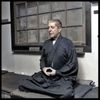4.5.2014 | 17:47
The following is taken from a dharma talk given by Jakusho Kwong-roshi on Feb. 18, 2011 during the Winter Ango sesshin at the Sonoma Mountain Zen Center
There are two teachings I want to talk about in reference to Dogen’s writing, Kuge; the first is the Heart Sutra, and the other is impermanency. This is from the late Maezumi-roshi’s Commentary 5 in his book ‘The Way of Everyday Life.’ He’s talking about the Three Dharma Marks of Existence and he begins by stating that basically everything is impermanent. There is nothing that does not change. No one can refute that. Everything is changing. “On the physiological level, the cells within our entire body, every seven years, are replaced.” After the sickness I had recently I felt like something had thoroughly changed in me from head to toe. Even if we try not to let it happen, it still does. This morning there was a little sunshine, now it’s raining. Last night there was a beautiful clear moon at two o’clock in the morning. He writes: “relationships among people – I like you, I don’t like you – even in a Zen community, you might not say these things but you own them” – it’s your feeling or emotion, and you can’t put it out there; you have to work with it – day to day, our moods change.
The second mark of existence is when impermanency takes the form of uncertainty or insecurity. Because you don’t know what’s going to happen, there’s nothing you can rely on and this is what brings people to practice, when they sense something is missing. Everything they’ve gone to school for, everything they’ve said or tried has resulted in still more searching, and that’s what leads people to Zen. It’s what originally led me to Zen. “Intrinsically impermanence is the nature of things. Because nothing at all is permanent, there’s no individual self that has independent existence.” meaning that it lasts forever. Because there’s no self, there’s no ego. What we have is just an idea of ego. Everything is impermanent, consequently everything is empty. This is the natural second step of impermanency. There’s no independent self nature that lasts forever.
From impermanency, or nothing fixed in the universe, the second mark is psychological uncertainty, and the third is no ego or no self. Impermanency, no-self, Nirvana. That’s it. ‘Flowers in the sky’ is another principle of impermanency – because flowers can’t exist outside of impermanency. We value their beauty because of their short life. That’s why we appreciate them. Flowers in the sky refers to the principle of impermanency and also that all existence is not real. Everything in front of you is not real, because you’ve named it. And because you’ve named it, you’ve divided yourself from it. As children grow up, they are originally in one-ness, but they can’t help it because as they grow up they begin objectifying. (Of course, that’s very wearing on the parents!) (laughter). But it’s also natural that the child acquires names for things, and develops that sense of subject and object. It can’t be helped. That’s human life. But children lose that sense of oneness. Yet it’s always there, and to find it again, to rediremains with you.
In his writing on Kuge, Katagiri-roshi says, “The emptiness behind all this is a wondrous being.” And this leads us to the Heart Sutra. The Heart Sutra states no eyes no ears - nothing is real. I was reading Shohaku Okumura’s commentary on Dogen’s Genjo Koan and in one section he says that everything is prajna. Everything we do is prajna. This is quite remarkable. I think Zen is the only tradition that emphasizes this. Zen in the arts, Zen in athletics, Zen in movement – this is a big point for us and we should use it. Zen emphasizes practice. Wherever you are, whatever you do, is prajna and practice. This is life-giving. This is restoration of your own Buddhahood. When you struggle, sometimes over little things, all you have to do is pause and feel. Feel the paper in your hands. Feel your utensils. Feel your tools. Feel the oryoki bowl. You can do these things. Work practice is no different than life itself. Prajna is right in front of you. That’s samsara and nirvana. You then have to transcend both of them. You can’t attach to either side.
So in the Heart Sutra, Avalokiteshvara clearly saw that form is emptiness and emptiness is form. When we read that, shiki soku ze ku, ku soku ze shiki, it means exactly that. But still this is dualistic. This is not the Heart Sutra’s conclusion. Soku ze refers to identity, or being identical. It can also mean as-it-is, or just like this. What it’s saying is that form is no other than emptiness, emptiness is no other than form. So, Katagiri says that soku has three meanings to it: one, it unifies two things. For instance, in kinhin, we’re trying to make individual movement become one. It’s hard to achieve, because some people have difficulty with spatial relationships; you think you’re close but actually you’re ten feet behind because maybe you are lost in your thoughts. That’s the first soku. The second is unifying two objects and becoming one with them. Again, it could be like milk and water – when you mix the two they become one. It’s also like your hand – there’s the back and there’s the palm. But it’s still one hand. Or like a piece of paper. A front sheet and a back face. The Sandokai also mentions the dark and the light. One can’t be found without the other. The third one is me and whatever is there – no gap. Subject and Object have disappeared. In this case, both sides are included. That side, this side. What it comes down to is that there are no sides. In the Sandokai it also says that in the dark all words become one. Or, cause and effect (karma) must return to the great reality. The great mystery. There’s no two; but we’ve made a separation. Now we have to come back. We have to restore ourselves and come back, and the middle way is to go beyond even that one.
There was a Christian priest in this area, and someone asked him a question, and he said, “I always return to one.” I wrote him a letter and asked, “Where does the one return to?” He never answered (laughter). But isn't that something? There are no sides. And because there are no sides this miraculous world appears – this world of prajna appears.
Bodhidharma wanted to transmit the dharma to one of his successors. There were four disciples – three men and one woman. One by one they had to reveal their practice and what they had inherited. The first one came up and Bodhidharma said, “You’ve got my skin.” The second one, the woman, came up and he said to her, “You’ve got my flesh.” After the third one spoke, he said “You’ve got my bone.” Then the fourth one, Eka, stood up with no words, walked – zazen sitting, zazen walking, zazen standing, zazen bowing and Bodhidharma said, “You’ve got my marrow.” He was the one who became the Second Ancestor. The first time I heard that story I thought ‘he must have had the best answer’ but really, they’re all the same. All the people are valued. So our conditioned mind works that way, because we’re trained to think this is the best and that’s the worst. So this is the higher teaching of the Heart Sutra. Form is form, emptiness is emptiness. There is no more form and emptiness. Because when we say form, emptiness is included already; in fact, we don’t even have to say it. It’s just there. And emptiness is just emptiness. The conclusion of the Heart Sutra – free from dualities, liberated from samsara and nirvana, free from like and dislike.
Coming back to Kuge: this is Katagiri’s talk at a teachers gathering. “In Buddhism, in general, ‘flowers in the sky’ means the principle of impermanency. That all existence is not real. In our ancestor’s teaching, true emptiness is a wondrous being. Since flowers bloom in the sky, or emptiness, they are not flowers. Since they are the sky, or emptiness, with flowers, it is not the sky or emptiness. It goes beyond this and that.” You can’t say what it is. Being, non-being. “The principle of impermanency means there’s no particular thing which causes all things to exist forever. It means that all existence is unreal. All exists, but all things are not real. And also, ‘flowers in the sky’ states the principle that true emptiness is a wondrous being.” He talks about this example: “We can see this incense burner on the altar, but it is not real. But our consciousness says that the burner exists completely in the previous moment and in the following moment. Consciously or unconsciously, we believe this – the burner exists - but it doesn’t exist; it exists as unreal. It’s pretty hard to understand this. If we understand emptiness, we immediately grasp emptiness. ‘Oh I understand emptiness.’ But if you grasp emptiness, it is already not emptiness – because you grasped it. So what you grasp, in your hand, in your mind, in your head, is not real emptiness. It’s the idea of emptiness. Real emptiness is a profound and refined state of existence, which causes all sentient beings to be restored.” Restored, meaning we are dynamically alive. Thank you.
Flokkur: Trśmįl og sišferši | Breytt s.d. kl. 17:49 | Facebook
Um bloggiš
OM - ॐ
Fęrsluflokkar
Tenglar
Hugleišslunįmskeiš į Ķslandi
- Námskeið hjá Hugleiðslu- og friðarmiðstöðinni
- Sahaja yoga-hugleiðsla
- Hugleiðslunámskeið hjá Brahma Kumaris
- Sri Chinmoy miðstöðin á Íslandi
- Andartak.is - Kundalini jóga og hugleiðsla
- Zen-hugleiðslunámskeið
- Dharma.is - Innsæishugleiðsla
- Innhverf íhugun
Frķ hugleišslunįmskeiš į Netinu
- Free Meditations
- Námskeið í búddískri hugleiðslu
- Námskeið í Kundalini yoga
- Free online meditation course
- Free Sahaja meditation course online
Hugleišsla
Hér er aš finna tengla žar sem žś getur lęrt og kynnt žér hugleišslu.
- Listin að hugleiða
- Zen á Íslandi - Zen-hugleiðsla
- Kristbjörg
- Kundalini-hugleiðsla
- Hugleiðslu- og friðarmiðstöðin
- SGI-búddismi á Íslandi
- Sri Chinmoy miðstöðin á Íslandi
- Skandinavíski yoga- og hugleiðsluskólinn
- Leiðbeiningar fyrir Zen-hugleiðslu
- Sahaja Yoga
- Brahma Kumaris - Raja Yoga hugleiðsla
- Jack Kornfield - Insight Meditation (vipassana)
- Centerpointe
- Ljósmiðlun
- Traditional Yoga and Meditation of the Himalayan Masters
- Innhverf íhugun
- Vipassana meditation course
Helg forn rit
- Veda-ritin
- Bhagavad Gita
- Bhagavad Gita
- Upanishads
- Upanishads
- Shiva sutra
- Brahma Sutra
- Yogasútrur Patanjalis
- Rig Veda
- Sama Veda
- Hatha Yoga Pradipika
- Shiva Samhita
- Gheranda Samhita
- Sacred Texts (Helg indversk rit)
- Biblían
- Dhammapada
- Kóraninn
Tķmarit um andleg mįlefni
- Tímaritið Knowledge of reality
- Bindu - Tímarit Skandinavíska yoga- og hugleiðsluskólans
- Tímaritið Gangleri
- Primary Point - Zen
- Efnisskrá Ganglera frá 1926
- The Sufism Journal online
- The Theosophist
Bękur į ķslensku um andleg mįlefni
- Starfsrækt (Karma yoga) - Swami Vivekananda
- Allar bækur Gunnars Dal
- Bækur eftir Alice Baily
- Martínus - Bækur á íslensku
- Launviska Vedabóka
Bękur um andleg mįlefni
- The Unknown Life of Jesus Christ
- Bók um Kriya Yoga
- Sjálfsævisaga Jóga
- Whispers from Eternity - Paramahansa Yogananda
- The Path - Swami Kriyananda
- God is for Everyone - Inspired by Yogananda
- My time with the master - Paramahansa Prajnanananda
- The Universe Within - Paramahansa Prajnanananda
- The art and science of Raja Yoga - Swami Kriyananda
- Complete work of Swami Vivekananda
- Gopi Krishna - Bækur, greinar og viðtöl
- Bókin Zen and the brain
- Zen Mind, Beginner´s Mind - Shunryu Suzuki-roshi
- Manual of Zen Buddhisim - D. T. Suzuki
- Stripping the Gurus
- Rödd þagnarinnar á ensku
- Eckhart Tolle - Stillness Speaks - Hljóðbók
- Bækur eftir Ramana Maharshi
- Saundarya Lahiri
- The Meditative Mind - Krishnamurti
- Krishnamurti´s Notebook
- Meditations - Krishnamurti
- The Serpent Power
- C. W. Leadbeater - Chakras: A Monograph
- Kundalini Yoga - Swami Sivananda
- Fríar bækur með Krishnamurti
- The Tibetan Book of Dead
- Karma Yoga - Swami Vivekananda
- Leiðarljós (Light on the Path) á ensku
- The Power of Now - Hljóðbók
- Hljóðbókin Breath sweeps mind eftir Jakusho Kwong-roshi
- Opening the Hand of Thought Bók eftir Kosho Uchiyama
- To shine one corner of the world : moments with Shunryu Suzuki : stories of a Zen master told by his students
- How to Cook your Life - Dogen
- The Art of Just Sitting: Essential Writings on the Zen Practice of Shikantaza
- On Zen Practice
- On Having No Head
Greinar um andleg mįlefni
- Greinasafn Lífspekifélagsins/Guðspekifélagsins
- Greinar eftir Sigvalda Hjálmarsson
- Greinar og rannskóknir tengdar kundalini
- Krishnamurti - Greinar, viðtöl og tilvitnanir
- Hugleiðingar um kenningar Sigvalda Hjálmarssonar - I. Hluti
- Hugleiðingar um kenningar Sigvalda Hjálmarssonar - II. hluti
- Greinar úr zen-tímaritinu Primary Point
- Greinar eftir dr. Erlend Haraldsson
- Greinasafn Jóns L. Arnalds
- Yður er í dag frelsari fæddur? - Njörður P. Njarðvík
- Yoga og geðrækt
- Leiðin til hugljómunar - Sigvaldi Hjálmarsson
- Geinar úr tímaritinu Quest
Żmsir tenglar andlegs ešlis - Ķslenskir
- Kærleikssetrið
- Jógakennarafélag Íslands
- Lífspekifélagið/Guðspekifélagið
- AA
- CoDa
- Viska og gleði
- Kærleikssamtökin
- Björg Einarsdóttir
- Trú.is
- LAUSNIN - Baráttusamtök gegn meðvirkni
- Dharma.is - Innsæishugleiðsla
- Dulheimar - Andleg þróunarheimspeki
- Vetrarbrautin.com
- Listi yfir skráð trú- og lífskoðunarfélög á Íslandi
Żmsir tenglar andlegs ešlis - Erlendir
- DharmaTalk með Thich Nhat Hanh
- Agni Yoga
- Meditation of the Himalayan Masters
- Vedanta Society
- Vedanta.com
- tantra-kundalini.com
- Ayurveda-próf - Hvaða líkamsgerð ertu?
- Prajnanamission
- Big Mind
- Vedanta Spiritual Library
- Great Integral Awakening
- Sounds True
- Wildmind - Buddhist Meditation
- Institute for Consciousness Research
- Biology of Kundalini
- Kundalini Research Network
- Hindu Tantrik Tradition
- Inner Self
- Spirit Voyage
- Dalai Lama kyrjar möntru úr Rig Veda
- Ýmislegt um Ramakrishna
- The Five Tibetan Rite
- Message from masters
- Bæklingur um sanskrítarframburð
- The Theosophical Society - International Headquarters
- Sri Vidya
- Vedanet
- Eastern tradition - Eastern Tradition Research Archive
- Lífspekifélög/Guðspekifélög um allan heim
Żmsir andans menn
- Sigvaldi Hjálmarsson
- J. Krishnamurti
- Ken Wilber
- Gopi Krishna
- Swami Sivananda
- Osho
- Deepak Chopra
- Swami Vivekananda
- Sri Ramakrishna
- Yogi Hari
- Eckhart Tolle
- Yogi Shanti Desai
- Yogi Amrit Desai
- Shunryu Suzuki roshi
- Ramana Maharishi
- Sri Aurobindo
- Paramahansa Yogananda
- Paramahamsa Hariharananda
- Jakusho Kwong-roshi
- Jack Kornfield
- Swami Rama
- Grétar Fells
- D. T. Suzuki
- Dalai Lama
- Thich Nhat Hanh
- Eckhart Tolle
- Helena Blavatsky
- Paramahamsa Prajnanananda
- Rupert Spira
- Bodhidharma
- Om Swami
Lķfspeki/Gušspeki
- Lífspekifélag Íslands
- Lífspekifélagið í USA
- Helena Blavatzky
- Facebook-síða Lífspekifélags Íslands
- Aðalstöðvar Lífspekifélagsins á Indlandi
Kriya Yoga
Hér er aš finna tengla tengda Kriya Yoga
- Kriya Yoga Institute
- Paramahansa Hariharananda
- Paramahamsa Prajnanananda
- Bækur um Kriya Yoga eftir Hariharananda og Prajnananda
- Self-Realization Fellowship
- Ananda: The Teaching of Paramahansa Yogananda
- Cyberspace Ashram for Kriya Yoga
- Bókin Sjálfsævisaga jóga (Autobiography of a Yogi)
- Kriya Yoga - Swami Shankarananda Giri
- Kriya Yoga - Yogi Dhirananda
- Bók um Kriya Yoga á Netinu
- Kriya Yoga in the Lahiri Mahasaya family tradition
- Babaji´s Kriya Yoga
- Myndbönd um kriya yoga
- Prajnanamission
- Babaji Kriya Hatha Yoga - 18 Kriya Postures
- Umsókn - Kennslustundir hjá SRF
Hatha Yoga (Lķkamsstöšur - Teygjur)
- Yogavin
- Jóga hjá Kristbjörgu
- Jóga Stúdíó
- Jógakennarafélag Íslands
- Jóga Jörð
- Jen Reviews
- Sólir
- Yogashala
- Jógakennarar og jógastöðvar á Íslandi
Zen
- Zen á Íslandi
- Sonoma Mountain Zen Center
- Bókin Zen Mind, Beginners Mind eftir Shunryu Suzuki-roshi
- Bókin No Beginning. No End eftir Jakusho Kwong-roshi kennara Zen á Íslandi
- Hljóðbókin Breath Sweeps Mind eftir Jakusho Kwong-roshi
- The Teaching of Shunryu Suzuki-roshi
- San Francisco Zen Center
- Myndbönd með Suzuki-roshi
- Plum Village - Thich Nhat Hanh
- Zen of Recovery - Mel Ash
- Zen Road
- Zen sútrur
- Kwan Um School of Zen
- Daily Zen
- Big Mind
- Zen Peacemakers
- Suzuki-roshi 50
- Hljóðbókin Zen mind, beginner´s mind
- The Suzuki Roshi Audio Archive
- Opening the Hand of Thought Bók eftir Kosho Uchiyama
- To shine one corner of the world : moments with Shunryu Suzuki : stories of a Zen master told by his students
- How to Cook your Life - Dogen
- The Art of Just Sitting: Essential Writings on the Zen Practice of Shikantaza
- On Zen Practice
Bloggvinir
-
 thesecret
thesecret
-
 gudjonbergmann
gudjonbergmann
-
 gyda
gyda
-
 heringi
heringi
-
 gudmundurhelgi
gudmundurhelgi
-
 braxi
braxi
-
 fruheimsmeistari
fruheimsmeistari
-
 vilborg-e
vilborg-e
-
 steina
steina
-
 ludvik
ludvik
-
 maggadora
maggadora
-
 baenamaer
baenamaer
-
 perlaheim
perlaheim
-
 vestfirdir
vestfirdir
-
 vglilja
vglilja
-
 palmig
palmig
-
 einherji
einherji
-
 andreaolafs
andreaolafs
-
 flinston
flinston
-
 birnarebekka
birnarebekka
-
 tilfinningar
tilfinningar
-
 dizadj
dizadj
-
 gylforce
gylforce
-
 esa-emorea777
esa-emorea777
-
 estersv
estersv
-
 eydis
eydis
-
 gudjonelias
gudjonelias
-
 heildraent-joga
heildraent-joga
-
 heildraent-lif
heildraent-lif
-
 guru
guru
-
 tru
tru
-
 fun
fun
-
 jensgud
jensgud
-
 josira
josira
-
 katrinsnaeholm
katrinsnaeholm
-
 kari-hardarson
kari-hardarson
-
 kiza
kiza
-
 kjarvald
kjarvald
-
 kristinnhalldor
kristinnhalldor
-
 kiddirokk
kiddirokk
-
 krilli
krilli
-
 laufherm
laufherm
-
 mariaannakristjansdottir
mariaannakristjansdottir
-
 manisvans
manisvans
-
 nanna
nanna
-
 aronsky
aronsky
-
 huldumenn
huldumenn
-
 ragjo
ragjo
-
 rose
rose
-
 straitjacket
straitjacket
-
 vinur
vinur
-
 nimbus
nimbus
-
 slembra
slembra
-
 svanurg
svanurg
-
 toshiki
toshiki
-
 hanoi
hanoi
-
 thorhallurheimisson
thorhallurheimisson
Heimsóknir
Flettingar
- Ķ dag (24.9.): 4
- Sl. sólarhring: 4
- Sl. viku: 28
- Frį upphafi: 96790
Annaš
- Innlit ķ dag: 3
- Innlit sl. viku: 20
- Gestir ķ dag: 3
- IP-tölur ķ dag: 3
Uppfęrt į 3 mķn. fresti.
Skżringar






Bęta viš athugasemd [Innskrįning]
Ekki er lengur hęgt aš skrifa athugasemdir viš fęrsluna, žar sem tķmamörk į athugasemdir eru lišin.